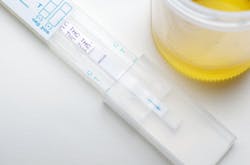In an expected revision to the random drug testing requirement, the Federal Motor Carrier Safety Administration has lowered the rate from 50% of a carrier’s average number of driver positions to 25%, beginning with the 2016 calendar year.
The change, at the discretion of the agency administrator, stems from three consecutive years during which the positive rate for controlled substances fell below a 1% threshold, according to the FMCSA notice. The minimum annual percentage rate for random alcohol testing will remain at 10%.
The testing rate will be increased again to 50% if the reported positive rate for any calendar year is equal to or greater than 1%, FMCSA points out.
The estimated positive rate in 2013 was 0.7 percent, FMCSA reports. For 2011 and 2012, the positive usage rate for drugs was estimated to be 0.9 percent and 0.6 percent, respectively. But “in order to ensure reliability of the data,” FMCSA decided to maintain the annual testing percentage rate at 50 percent and “sought additional information” related to drivers’ positive test rates.
The ensuing change “reflects the sustained low positive test rate” and will result in an estimated $50 million in annual savings to motor carriers by requiring that fewer drivers be tested, FMCSA says.
The question for carriers is whether or not to change procedures that have proved successful in deterring drivers from drug and alcohol violations.
American Trucking Assns. (ATA) Executive Vice President and Chief of National Advocacy Dave Osiecki anticipated such an announcement at last month’s ATA Safety, Security and Human Resources National Conference.
“If we are able to convince DOT that our random drug testing positive result is below 1% for three years, which it has been, and if DOT says we can lower the testing rate from 50% to 25%, here’s the question: Would you do it?” Osiecki said. “I don’t know who drives this within your company, whether it’s the HR side or the safety side, but would you actually think about 25%? The rule allows that to happen. We’re the only industry that’s still at the 50% rate of testing: FAA and rail are at 25%. This is something that you care about, and something that you can take advantage of—knowing that the deterrence effect is still there at 25%.”
About the Author
Kevin Jones 1
Editor
Kevin has served as editor-in-chief of Trailer/Body Builders magazine since 2017—just the third editor in the magazine’s 60 years. He is also editorial director for Endeavor Business Media’s Commercial Vehicle group, which includes FleetOwner, Bulk Transporter, Refrigerated Transporter, American Trucker, and Fleet Maintenance magazines and websites.
